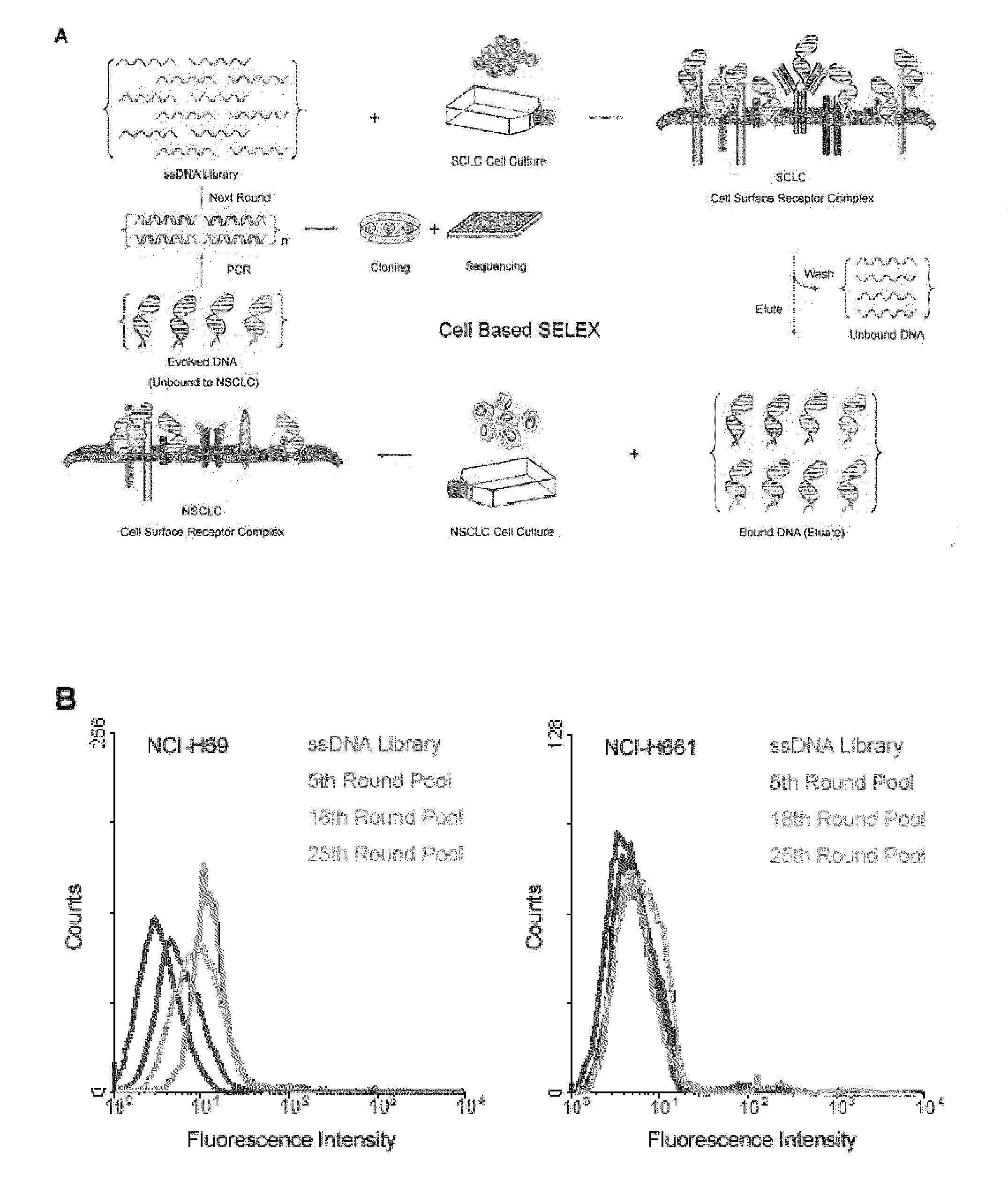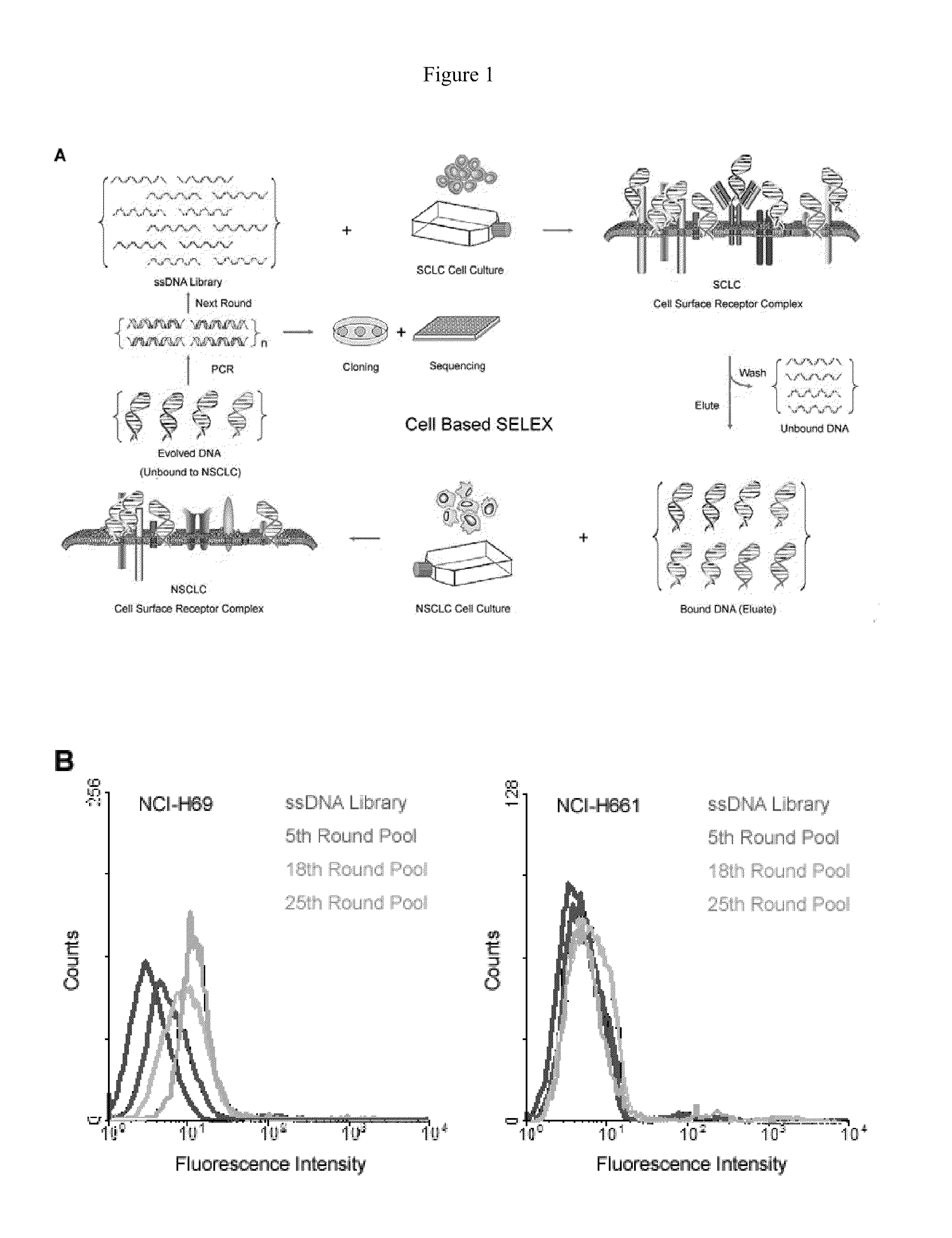Aptamers that bind abnormal cells
- Summary
- Abstract
- Description
- Claims
- Application Information
AI Technical Summary
Benefits of technology
Problems solved by technology
Method used
Image
Examples
example 1
Materials and Methods
[0039]Chemicals: Unless otherwise noted, all chemicals were purchased from Sigma-Aldrich and Fisher Scientific.
[0040]Buffers: Washing buffer was prepared by dissolving glucose (4.5 g / L), MgCl2 (5 mM), and BSA (1 mg / mL) in Dulbecco's PBS (pH 7.3). Yeast tRNA (0.1 mg / ml) was added in washing buffer to prepare binding buffer with minimal nonspecific binding.
[0041]Cell culture: NCI-H69 (small cell carcinoma), NCI-H661 (large cell carcinoma), NCI-H146 (small cell carcinoma), NCI-H128 (small cell carcinoma), NCI-H23 (adenocarcinoma), NCI-H1385 (squamous cell carcinoma), CCRF-CEM (T cell acute lymphoblastic leukemia), and Ramos (B cell human Burkitt's lymphoma) cells were purchased from American Type Culture Collection (ATCC), and maintained at 37° C. and 5% CO2 in RPMI 1640 medium (ATCC) supplemented with 10% heat-inactivated fetal bovine serum (FBS) (GIBCO) and 100 units / ml penicillin-streptomycin (Cellgro). IMEA (liver cancer) and BNL (liver cancer) cells were obtai...
example 2
SELEX for Whole Live Cancer Cells
[0060]Referring to FIG. 1, to develop cell specific aptamer probes, live cancer cells were directly used as the target for cell-SELEX. This approach was adapted in a few aspects to work with floating aggregates of SCLC and adherent monolayers of NSCLC, which are two typical growth patterns of lung cancer culture. Because of their heterogeneity and poor viability, it is more challenging to perform cell-SELEX with lung cancer than leukemia. NSCLC (large cell) was adopted as a control for cell-SELEX to generate aptamers exclusive to the cell surface markers of SCLC. These cell surface markers are so exclusive to SCLC that normal lung epithelial cells are also not expected to bear them and cross-react with developed aptamers, as observed in previous studies with antibodies. With counter-selection against control cells, the aptamers achieve great selectivity necessary for the reliable detection of lung cancer antigens.
[0061]In the actual selection, a cult...
example 3
Enzymatic Treatment of Cell Surface Markers
[0066]The putative cell surface targets were examined by enzymatic treatment to further verify the binding of aptamers to SCLC cell surface markers. After brief treatment of cells with trypsin or proteinase K, diminished binding of aptamers to SCLC cells was observed by flow cytometry in both cases. The same trend was observed using confocal microscopy, only limited amount of fluorescent aptamers getting retained on enzyme treated cell surfaces. These results suggest that selected aptamers indeed bind to cell membrane target molecules, and these SCLC cell surface markers can be affected by protease.
PUM
| Property | Measurement | Unit |
|---|---|---|
| Dissociation constant | aaaaa | aaaaa |
| Dissociation constant | aaaaa | aaaaa |
| Dissociation constant | aaaaa | aaaaa |
Abstract
Description
Claims
Application Information
 Login to View More
Login to View More - R&D
- Intellectual Property
- Life Sciences
- Materials
- Tech Scout
- Unparalleled Data Quality
- Higher Quality Content
- 60% Fewer Hallucinations
Browse by: Latest US Patents, China's latest patents, Technical Efficacy Thesaurus, Application Domain, Technology Topic, Popular Technical Reports.
© 2025 PatSnap. All rights reserved.Legal|Privacy policy|Modern Slavery Act Transparency Statement|Sitemap|About US| Contact US: help@patsnap.com


